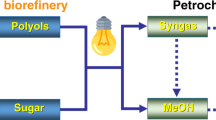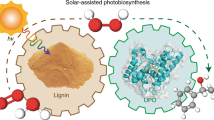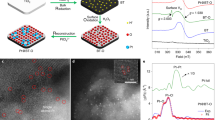Abstract
Photocatalytic hydrogen production from biomass is a promising alternative to water splitting thanks to the oxidation half-reaction being more facile and its ability to simultaneously produce solar fuels and value-added chemicals. Here, we demonstrate the coproduction of H2 and diesel fuel precursors from lignocellulose-derived methylfurans via acceptorless dehydrogenative C−C coupling, using a Ru-doped ZnIn2S4 catalyst and driven by visible light. With this chemistry, up to 1.04 g gcatalyst−1 h−1 of diesel fuel precursors (~41% of which are precursors of branched-chain alkanes) are produced with selectivity higher than 96%, together with 6.0 mmol gcatalyst−1 h−1 of H2. Subsequent hydrodeoxygenation reactions yield the desired diesel fuels comprising straight- and branched-chain alkanes. We suggest that Ru dopants, substituted in the position of indium ions in the ZnIn2S4 matrix, improve charge separation efficiency, thereby accelerating C−H activation for the coproduction of H2 and diesel fuel precursors.
This is a preview of subscription content, access via your institution
Access options
Access Nature and 54 other Nature Portfolio journals
Get Nature+, our best-value online-access subscription
$29.99 / 30 days
cancel any time
Subscribe to this journal
Receive 12 digital issues and online access to articles
$119.00 per year
only $9.92 per issue
Buy this article
- Purchase on Springer Link
- Instant access to full article PDF
Prices may be subject to local taxes which are calculated during checkout





Similar content being viewed by others
Data availability
Additional and supporting data are provided in the Supplementary Information. Further data that support the plots within this Article and other findings of this study are available from the corresponding author upon reasonable request.
References
Shih, C. F., Zhang, T., Li, J. & Bai, C. Powering the future with liquid sunshine. Joule 2, 1925–1949 (2018).
Li, X. B. et al. Self-assembled framework enhances electronic communication of ultrasmall-sized nanoparticles for exceptional solar hydrogen evolution. J. Am. Chem. Soc. 139, 4789–4796 (2017).
Selcuk, S. & Selloni, A. Facet-dependent trapping and dynamics of excess electrons at anatase TiO2 surfaces and aqueous interfaces. Nat. Mater. 15, 1107–1112 (2016).
Han, G. et al. Visible-light-driven valorization of biomass intermediates integrated with H2 production catalyzed by ultrathin Ni/CdS nanosheets. J. Am. Chem. Soc. 139, 15584–15587 (2017).
Shi, R. et al. Interstitial P-doped CdS with long-lived photogenerated electrons for photocatalytic water splitting without sacrificial agents. Adv. Mater. 30, 1705941 (2018).
Shown, I. et al. Carbon-doped SnS2 nanostructure as a high-efficiency solar fuel catalyst under visible light. Nat. Commun. 9, 169 (2018).
Yang, W. et al. Enhanced photoexcited carrier separation in oxygen-doped ZnIn2S4 nanosheets for hydrogen evolution. Angew. Chem. Int. Ed. 55, 6716–6720 (2016).
Luo, N. et al. Photocatalytic oxidation–hydrogenolysis of lignin β-O-4 models via a dual light wavelength switching strategy. ACS Catal. 6, 7716–7721 (2016).
Guo, M., Song, W. & Buhain, J. Bioenergy and biofuels: history, status and perspective. Renew. Sust. Energ. Rev. 42, 712–725 (2015).
Zhang, P. et al. Streamlined hydrogen production from biomass. Nat. Catal. 1, 332–338 (2018).
Wakerley, D. W. et al. Solar-driven reforming of lignocellulose to H2 with a CdS/CdOx photocatalyst. Nat. Energy 2, 17021 (2017).
Kuehnel, M. F. & Reisner, E. Solar hydrogen generation from lignocellulose. Angew. Chem. Int. Ed. 57, 3290–3296 (2018).
Latorre-Sanchez, M., Primo, A. & Garcia, H. P-doped graphene obtained by pyrolysis of modified alginate as a photocatalyst for hydrogen generation from water–methanol mixtures. Angew. Chem. Int. Ed. 52, 11813–11816 (2013).
Karp, E. M. et al. Renewable acrylonitrile production. Science 358, 1307–1310 (2017).
Zhou, Z.-z, Liu, M. & Li, C.-J. Selective copper–N-heterocyclic carbene (copper-NHC)-catalyzed aerobic cleavage of β-1 lignin models to aldehydes. ACS Catal. 7, 3344–3348 (2017).
Bond, J. Q. et al. Production of renewable jet fuel range alkanes and commodity chemicals from integrated catalytic processing of biomass. Energy Environ. Sci. 7, 1500–1523 (2014).
Via, L. D., Recchi, C., Davies, T. E., Greeves, N. & Lopez-Sanchez, J. A. Visible-light-controlled oxidation of glucose using titania-supported silver photocatalysts. ChemCatChem 8, 3475–3483 (2016).
Xie, S. et al. Visible light-driven C–H activation and C–C coupling of methanol into ethylene glycol. Nat. Commun. 9, 1181 (2018).
Deneyer, A. et al. Direct upstream integration of biogasoline production into current light straight run naphtha petrorefinery processes. Nat. Energy 3, 969–977 (2018).
de Beeck, B. O. et al. Direct catalytic conversion of cellulose to liquid straight-chain alkanes. Energy Environ. Sci. 8, 230–240 (2015).
Climent, M. J., Corma, A. & Iborra, S. Conversion of biomass platform molecules into fuel additives and liquid hydrocarbon fuels. Green Chem. 16, 516–547 (2014).
Shylesh, S., Gokhale, A. A., Ho, C. R. & Bell, A. T. Novel strategies for the production of fuels, lubricants and chemicals from biomass. Acc. Chem. Res. 50, 2589–2597 (2017).
Zhu, Y. et al. Efficient synthesis of 2,5-dihydroxymethylfuran and 2,5-dimethylfuran from 5-hydroxymethylfurfural using mineral-derived Cu catalysts as versatile catalysts. Catal. Sci. Technol. 5, 4208–4217 (2015).
Yang, X. et al. Efficient synthesis of furfuryl alcohol and 2-methylfuran from furfural over mineral-derived Cu/ZnO catalysts. ChemCatChem 9, 3023–3030 (2017).
Chatterjee, M., Ishizaka, T. & Kawanami, H. Hydrogenation of 5-hydroxymethylfurfural in supercritical carbon dioxide–water: a tunable approach to dimethylfuran selectivity. Green Chem. 16, 1543–1551 (2014).
Thananatthanachon, T. & Rauchfuss, T. B. Efficient production of the liquid fuel 2,5-dimethylfuran from fructose using formic acid as a reagent. Angew. Chem. Int. Ed. 49, 6616–6618 (2010).
Guo, W. et al. Efficient hydrogenolysis of 5-hydroxymethylfurfural to 2,5-dimethylfuran over a cobalt and copper bimetallic catalyst on N-graphene-modified Al2O3. Green Chem. 18, 6222–6228 (2016).
Win, D. T. Furfural-gold from garbage. AU J. Technol. 8, 185–190 (2005).
Lange, J. P., van der Heide, E., van Buijtenen, J. & Price, R. Furfural—a promising platform for lignocellulosic biofuels. ChemSusChem 5, 150–166 (2012).
Li, G. et al. Synthesis of high-quality diesel with furfural and 2-methylfuran from hemicellulose. ChemSusChem 5, 1958–1966 (2012).
Corma, A., de la Torre, O. & Renz, M. Production of high quality diesel from cellulose and hemicellulose by the Sylvan process: catalysts and process variables. Energy Environ. Sci. 5, 6328–6344 (2012).
Huber, G. W., Chheda, J. N., Barrett, C. J. & Dumesic, J. A. Production of liquid alkanes by aqueous-phase processing of biomass-derived carbohydrates. Science 308, 1446–1450 (2005).
Gumidyala, A., Wang, B. & Crossley, S. Direct carbon–carbon coupling of furanics with acetic acid over Bronsted zeolites. Sci. Adv. 2, e1601072 (2016).
Bond, J. Q., Alonso, D. M., Wang, D., West, R. M. & Dumesic, J. A. Integrated catalytic conversion of gamma-valerolactone to liquid alkenes for transportation fuels. Science 327, 1110–1113 (2010).
Balakrishnan, M., Sacia, E. R. & Bell, A. T. Syntheses of biodiesel precursors: sulfonic acid catalysts for condensation of biomass-derived platform molecules. ChemSusChem 7, 1078–1085 (2014).
Jiao, X. et al. Defect-mediated electron-hole separation in one-unit-cell ZnIn2S4 layers for boosted solar-driven CO2 reduction. J. Am. Chem. Soc. 139, 7586–7594 (2017).
Yang, Y., Sun, C., Ren, Y., Hao, S. & Jiang, D. New route toward building active ruthenium nanoparticles on ordered mesoporous carbons with extremely high stability. Sci. Rep. 4, 4540 (2014).
Ohba, T. et al. EXAFS studies of Pd nanoparticles: direct evidence for unusual Pd–Pd bond elongation. Chem. Lett. 44, 803–805 (2015).
Niu, L. et al. Photo-induced oxidant-free oxidative C–H/N–H cross-coupling between arenes and azoles. Nat. Commun. 8, 14226 (2017).
Meng, L. et al. Gold plasmon-induced photocatalytic dehydrogenative coupling of methane to ethane on polar oxide surfaces. Energy Environ. Sci. 11, 294–298 (2018).
Dutta, S. & Saha, B. Hydrodeoxygenation of furylmethane oxygenates to jet and diesel range fuels: probing the reaction network with supported palladium catalyst and hafnium triflate promoter. ACS Catal. 7, 5491–5499 (2017).
Ji, S., Cao, W., Yu, Y. & Xu, H. Dynamic diselenide bonds: exchange reaction induced by visible light without catalysis. Angew. Chem. Int. Ed. 53, 6781–6785 (2014).
Nomura, M., Takayama, C. & Kajitani, M. Electrochemical behavior of nickeladithiolene S,S′-dialkyl adducts: evidence for the formation of a metalladithiolene radical by electrochemical redox reactions. Inorg. Chem. 42, 6441–6446 (2003).
Naesborg, L. et al. Direct enantio- and diastereoselective oxidative homocoupling of aldehydes. Chem. Eur. J. 24, 14844–14848 (2018).
King, E. R., Hennessy, E. T. & Betley, T. A. Catalytic C–H bond amination from high-spin iron imido complexes. J. Am. Chem. Soc. 133, 4917–4923 (2011).
Mironenko, A. V. & Vlachos, D. G. Conjugation-driven ‘reverse Marslvan Krevelen’-type radical mechanism for low-temperature C–O bond activation. J. Am. Chem. Soc. 138, 8104–8113 (2016).
Kang, Y. et al. Selective breaking of hydrogen bonds of layered carbon nitride for visible light photocatalysis. Adv. Mater. 28, 6471–6477 (2016).
Li, H. et al. Construction and nanoscale detection of interfacial charge transfer of elegant Z-scheme WO3/Au/In2S3 nanowire arrays. Nano Lett. 16, 5547–5552 (2016).
Zhu, J. et al. Direct imaging of highly anisotropic photogenerated charge separations on different facets of a single BiVO4 photocatalyst. Angew. Chem. Int. Ed. 54, 9111–9114 (2015).
Huang, X. et al. Efficient plasmon-hot electron conversion in Ag-CsPbBr3 hybrid nanocrystals. Nat. Commun. 10, 1163 (2019).
Gou, X. et al. Shape-controlled synthesis of ternary chalcogenide ZnIn2S4 and CuIn(S,Se)2 nano-/microstructures via facile solution route. J. Am. Chem. Soc. 128, 7222–7229 (2006).
Xia, Q.-N. et al. Pd/NbOPO4 multifunctional catalyst for the direct production of liquid alkanes from aldol adducts of furans. Angew. Chem. Int. Ed. 53, 9755–9760 (2014).
Luo, N. et al. Visible-light-driven self-hydrogen transfer hydrogenolysis of lignin models and extracts into phenolic products. ACS Catal. 7, 4571–4580 (2017).
Briois, V. et al. SAMBA: The 4–40 keV X-ray absorption spectroscopy beamline at SOLEIL. UVX 2010, 41–47 (2011).
Ankudinov, A. L., Ravel, B., Rehr, J. J. & Conradson, S. D. Real-space multiple-scattering calculation and interpretation of X-ray-absorption near-edge structure. Phys. Rev. B 58, 7565–7576 (1998).
Ravel, B. & Newville, M. ATHENA, ARTEMIS, HEPHAESTUS: data analysis for X-ray absorption spectroscopy using IFEFFIT. J. Synchrotron Radiat. 12, 537–541 (2005).
Acknowledgements
The authors acknowledge SOLEIL for provision of synchrotron radiation facilities and thank G. Alizon for technical assistance in using beamline SAMBA. The authors also acknowledge financial support from the National Natural Science Foundation of China (21721004, 21690082, 21690084, 21690080), the Strategic Priority Research Program of Chinese Academy of Sciences (XDB17020300, XDB17000000), the National Natural Science Foundation of China (21711530020), the University of Trieste (programme FRA 2018, project INSIDE), the Italian Ministry for University and Research (MIUR, programme FFABR 2017) and the INSTM consortium.
Author information
Authors and Affiliations
Contributions
N.L. and F.W. conceived the research. N.L. conducted most of the experiments in this work, analysed the data and wrote the manuscript. XANES/EXAFS experiments and their discussion were done by T.M., assisted by E.F. T.M., P.F. and E.F. fully revised the manuscript. J.Z. and N.L. designed and fabricated the LED photoreactor. The variation of CPD was measured by W.N., assisted by F.F. J.M.L. carried out the DFT calculations. Transient absorption analysis was done by J.X.L., assisted by S.J. HAADF-STEM and EDX mappings were performed by M.H. Cyclic voltammetry was measured by L.L. Mott–Schottky measurements were done by C.M. T.H. and M.W. added to the discussion and contributed to the preparation of the manuscript. F.W. planned, supervised and led the project.
Corresponding author
Ethics declarations
Competing interests
The authors declare no competing interests.
Additional information
Publisher’s note: Springer Nature remains neutral with regard to jurisdictional claims in published maps and institutional affiliations.
Supplementary information
Supplementary Information
Supplementary methods, Supplementary Notes 1-2, Supplementary Tables 1-8, Supplementary Figs. 1–58, Supplementary references
Rights and permissions
About this article
Cite this article
Luo, N., Montini, T., Zhang, J. et al. Visible-light-driven coproduction of diesel precursors and hydrogen from lignocellulose-derived methylfurans. Nat Energy 4, 575–584 (2019). https://doi.org/10.1038/s41560-019-0403-5
Received:
Accepted:
Published:
Issue Date:
DOI: https://doi.org/10.1038/s41560-019-0403-5
This article is cited by
-
Photocatalysts for steering charge transfer and radical reactions in biorefineries
Nature Synthesis (2024)
-
Pd single atoms cooperate with S vacancies in ZnIn2S4 nanosheets for photocatalytic pure-water splitting
Science China Chemistry (2024)
-
The unique spontaneous polarization property and application of ferroelectric materials in photocatalysis
Nano Research (2024)
-
A Highly Efficient Ni/Al2O3-LaOx Catalyst for the Reductive Amination of Furfural to Furfurylamine: the Promoting Effect of La
Chemical Research in Chinese Universities (2024)
-
Radical generation and fate control for photocatalytic biomass conversion
Nature Reviews Chemistry (2022)



